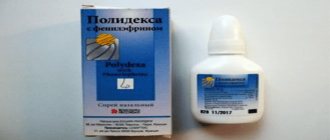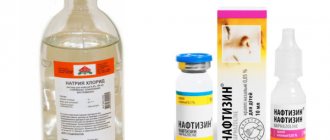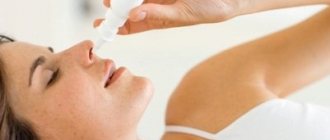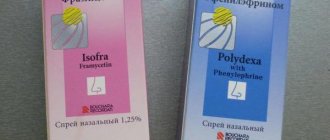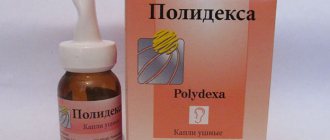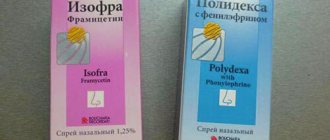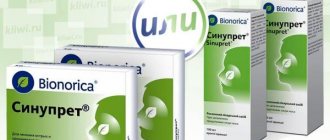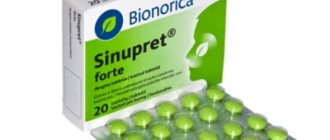Polydexa
Polydexa is a combination drug containing a hormonal component - dexamethasone , a vasoconstrictor - phenylephrine , as well as a combination of two broad-spectrum antibacterial agents - neomycin and polymyxin B. Dexamethasone has an anti-inflammatory and decongestant effect, and in combination with phenylephrine it relieves congestion well. Antibacterial components have a bactericidal and bacteriostatic effect on a fairly large number of pathogenic bacteria.
Polydexa is produced in the form of a nasal spray, thereby ensuring ease of use and dosing accuracy. However, given the fairly powerful antibacterial effect, the drug should only be prescribed by a doctor if there are strict indications!
Polydexa or Vibrocil?
The drugs have different pharmacological effects. Vibrocil contains the following substances: dimethindene maleate and phenylephrine. The first substance relieves the chain of allergic reactions, the second fights swelling and inflammation, i.e. in total we get anti-allergic, anti-edematous and anti-inflammatory effects.
Vibrocil can be purchased in the form of a spray, drops and gel. The drug is used for various types of rhinitis that do not have bacterial microflora. These could be allergic and viral rhinitis, chronic sinusitis, otitis media (in this case, Vibrocil eliminates the symptoms).
- Vibrocil is approved for use in children under one year of age. Clinical trials have shown the safety of using this drug in this age group.
- Unlike Polydexa, Vibrocil cannot treat bacterial rhinitis, so it cannot be called an analogue. To replace polydex, ideally, only drugs that contain antibacterial components are selected.
Vibrocil is cheaper than Polydex. The price of nasal drops (15 ml) is approximately 290 rubles. Despite the fact that the drug is cheaper, it cannot be used as an analogue, therefore, in principle, there is no need to compare these products, they are different.
Sinupret
Sinupret is a herbal . It contains a hydroalcoholic extract from medicinal plants : gentian, primrose, sorrel, elderberry and verbena. The complex of these herbs thins the secretion and promotes its better outflow from the nasal sinuses, has an anti-inflammatory and antiseptic effect, and reduces swelling of the mucous membrane. Sinupret helps fight nasal congestion and also prevents the development of complications.
The drug is available in several dosage forms: tablets, oral drops and syrup. The choice of release form depends on the patient’s age and personal preferences.
Sinupret should be taken with caution by people prone to allergic reactions. Due to the ethanol content in the drops, it is better to avoid using the drug in case of alcohol dependence, as well as in children under two years of age.
How to choose the right analogue?
Let's say that the patient is over 2.5 years old and was prescribed Polydex. After several doses of the drug, the patient complained of a burning sensation and severe swelling, which did not go away after 2–3 minutes. Subsequent injections also brought negative symptoms to the patient.
Here the doctor has to follow the following tactics.
- Firstly, the analogue must be selected according to the permissible age of the patient, and also that the composition of the product must include an antibiotic, or, in extreme cases, an antiseptic.
- It all depends on the clinical picture of the disease. If we are dealing with high body temperature, aggravated symptoms, and purulent discharge, then in this case only an antibiotic is needed, both locally and systemically.
- If a bacterial runny nose is just beginning, when yellow or green snot appears, and the patient’s body temperature is normal, or does not exceed 37.2 degrees (in children under three years of age), you can try to treat the runny nose with antiseptic solutions, i.e. . Nasal drops (similar to Polydex) are suitable.
- In any case, before starting treatment, the patient should be examined by an otolaryngologist to exclude the development of sinusitis, other sinusitis and otitis media. We are not even talking about self-medication with antibacterial agents.
What is the difference?
Despite the same areas of application and similar effects, Polydexa and Sinupret belong to completely different groups of drugs and have different indications for use.
Polydexa is a fairly powerful tool in the arsenal of an otorhinolaryngologist . The combination of hormonal and antibacterial components allows you to effectively combat severe cases of infections of the nose and paranasal sinuses, even in the form of monotherapy.
However, independent or illiterate prescription of the drug can cause the opposite effect. If Polydexa is used for a viral infection, dexamethasone will only weaken the natural factors of antiviral defense, and antibiotics will be used in vain.
The hormonal component may have a negative effect on the body's excretory system in patients with chronic kidney disease. And phenylephrine, being an alpha-adrenergic agonist, is contraindicated in people with coronary heart disease and arterial hypertension.
Sinupret is used in the complex therapy of mild sinusitis , most often of viral etiology. This drug is ineffective for allergic and vasomotor rhinitis, and for rhinitis during pregnancy.
The prescription of Sinupret most often accompanies the use of vasoconstrictor drugs, mechanical cleaning of the nasal passages from mucus, and sometimes the use of oral antibacterial drugs.
It should be remembered that the content of herbal components may contribute to the deterioration of the condition due to allergic edema in case of intolerance to one or more components of the drug.
Contraindications and side effects
Side effects on the drug Polydex are quite rare. Both adults and children tolerate drop therapy quite easily. If a negative reaction occurs in the body, then, as a rule, this is due to non-compliance with the instructions for use.
Side effect:
- Allergic reactions
- Burning mucous membranes
- Swelling of the nasal cavity
- Skin rashes
- Insomnia
- Increased irritability and nervousness
- Increased heart rate
The drug is not prescribed:
- Children under 2.5 years old
- During pregnancy and lactation
- For glaucoma
- For kidney diseases
- If diseases of the cardiovascular system are detected
- For otitis caused by viruses
- In case of violation of the integrity of the eardrums
The drug is practically not absorbed by mucosal cells and does not enter the bloodstream; there is no evidence of an overdose.
Polydexa with phenylephrine should be used according to the instructions or prescription of a doctor. If the spray is prescribed as an additional method for eliminating sinusitis, it is necessary to become familiar with the interaction of the drops with other drugs. Often, the wrong combination can lead to an increase in blood pressure or a persistent and long-lasting effect of pupil dilation.
When should or should not these drugs be used?
Polydexa and Sinupret can be excellent assistants in the treatment of nasal diseases, but the choice of drug should be taken with great responsibility. It is best to entrust this choice to a specialist .
When is Polydexa used?
- As the main etiopathogenetic drug for the treatment of acute and chronic purulent sinusitis, sinusitis, frontal sinusitis.
- In complex therapy of purulent otitis, adenoiditis, tonsillitis.
- Treatment of allergic rhinitis.
- Postoperative therapy for the prevention and treatment of purulent complications.
When is Sinupret used?
- Acute rhinosinusitis of both viral and bacterial etiology.
- Chronic rhinitis, which is accompanied by the release of a viscous secretion.
- In the complex therapy of otitis media, sinusitis, frontal sinusitis, adenoiditis, tonsillitis.
- To eliminate postoperative swelling after surgical interventions on the oral and nasal cavity.
What should you keep in mind?
A few important notes about the use of these drugs:
- Sinupret tablets should not be used in people with lactase deficiency due to the content of sucrose, glucose and lactose monohydrate in the tablet.
- Sinupret drops are prescribed with caution for liver diseases, epilepsy and after severe traumatic brain injuries.
- Polydexa is contraindicated in diseases accompanied by perforation of the eardrum.
- The use of Polydexa is contraindicated in case of angle-closure glaucoma or suspicion of it.
- Taking Polydex is incompatible with the use of MAO inhibitors.
- The use of Polydex and Sinupret during pregnancy and breastfeeding is possible only if the benefit to the mother outweighs the potential risk to the fetus and child.
Indications for use
The spray is actively used by doctors to restore the condition of the mucous membranes of the upper respiratory tract.
Prescribed for diseases:
- Sinusitis
- Rhinitis at any stage
- Sinusitis
- Rhinopharyngitis
- Prevention of the development of viral diseases in the postoperative period
Greater results in getting rid of sinusitis can be achieved if you include Polydexa in the main treatment as a local remedy. For sinusitis, the drug acts against bacteria, viruses and inflammation, has an antihistamine effect, thins mucus, helping it come out of the nasal cavity more easily, reduces swelling and makes breathing easier. Treatment with drops occurs quite quickly. With proper and regular use, the patient feels relief within a few days.
Dosage of the drug
As a rule, the dosage of the medicine is prescribed based on the instructions attached to the drug. For adults, Polydex is instilled into the nose for sinusitis 4-5 times a day, one injection. In children, the dosage is reduced to 3 times a day. It is allowed to reduce the rate of drops or the number of applications per day if the disease has just begun to develop.
Polydexa is administered into the nose for 7 days in both children and adults. After the specified period, use of the spray must be discontinued. If there is no visible effect, the doctor must select an analogue, since bacteria begin to develop resistance to the antibiotics included in Polydex.
Polydexa or Sofradex?
Sofradex is an analogue of Polydex, although their composition is different, but the principle of action is largely similar. Both drugs have antibacterial substances and glucocorticosteroids.
In Sofradex, gramicidin and framycetin sulfate act as antibacterial agents, and the glucocorticosteroid is dexamethasone. As you can see, Polydex and Sofradex are quite strong drugs that contain two antibacterial agents.
Unlike polydex, sofradex is also used in ophthalmic practice. The main purpose of Sofradex is the treatment of bacterial and inflammatory diseases of the eyes and ears.
Instructions for use of Sofradex for ears.
The instructions for the drug do not contain instructions for using Sofradex for rhinitis. Despite this, this drug is widely used to treat bacterial rhinitis in adults and children.
When making a choice towards one of the drugs - Polydex or Sofradex, first of all, you need to proceed from the sensitivity of bacteria to the antibiotics that are part of these drugs. The choice of drug is carried out and the doctor’s experience will always tell you which drug will be more effective for a given clinical picture.
The price for Sofradex (eye and ear drops, 5 ml) is 330 rubles. Conclusion: the price of Polydex and Sofradex is at the same level.
Is Polydex addictive?
Polydex spray with phenylephrine is a medical drug whose action is aimed at reducing mucous discharge from the nasal cavity. It is intended for complex treatment. Polydex instructions cover all the positive aspects of the product, warnings and categorical contraindications.
It contains the following components:
- Neomycin sulfate - 10 milligrams;
- Polymyxin sulfate - 10,000 units;
- Phenylephrine hydrochloride - 2.5 milligrams;
- Metasulfobenzonate - 250 mcg;
- Dexamethasone - 0.25 milligrams.
Action of the product
Phenylephrine is aimed at constricting blood vessels and facilitating the process of breathing through the nose. Dexamethasone eliminates possible inflammation, and the polymyxin component is responsible for the destruction of pathogenic microorganisms. Inflammatory infections develop precisely under the influence of microorganisms.
Using a nasal spray or Polydex ear drops, the course of treatment for your disease will become effective and comprehensive. The product contains hormones, antibiotics and components aimed at constricting blood vessels. Instructions for use are attached to each unit of the drug. Unfortunately, the spray is powerless against coccal infections.
As for use, adults can use the drug no more than 5 times in 24 hours and one injection. Children whose ages range from 2 to 16 years can use the nasal spray no more than 3 times a day. The number of injections is no more than one.
Contraindications
The following contraindications exist for the use of nasal spray or other form:
- high level of sensitivity to the components contained in the composition;
- the presence of infections due to chickenpox or herpes;
- problems with urination;
- presence of closed glaucoma;
- It is prohibited to prescribe Polydex during pregnancy, as well as during breastfeeding;
- for kidney diseases;
- during treatment with MAO inhibitors.
Note to everyone! People who have heart disease are allowed to use Polydex strictly as prescribed by the treating specialist.
There are cases of an allergic reaction to a drug containing phenylephrine. It may appear as:
- rashes on the skin;
- itching of the skin;
- dry nasal mucosa.
Overdose is fraught with:
- presence of headache;
- rapid heartbeat;
- sleep disturbance;
- pallor of the skin.
It is strictly forbidden to rinse the sinuses with this drug containing phenylephrine. Its parallel use with the following drugs is strictly prohibited:
- gentamicin;
- netilmicin;
- monomycin;
- amikacin;
- streptomycin.
Storage
Polydex spray can be stored at a temperature of 25 degrees for about 3 years. It can be purchased only by prescription.
New generation drug
According to scientists, Polydex with phenylephrine is a combined effective modern remedy that eliminates ear and nasal diseases. Widely used by specialists to eliminate complications after diseases associated with ENT organs.
Flu, infectious, viral and colds quite often carry a hidden danger that manifests itself as complications.
Eliminating such problems is fundamentally different from traditional methods of therapy, therefore, each step is clearly described in the instructions for use.
Various forms of complications of influenza arise in the process of the appearance of pathogenic microorganisms that rapidly penetrate through the organs of vision, ear canals and respiratory system damaged by viruses.
Polydex nasal spray has an anti-inflammatory effect. It effectively destroys the microflora of bacteria, whereby, in the shortest possible time, purulent complications will be eliminated.
Instructions for use
It has been proven that Polydexa with phenylephrine has the following features:
- bactericidal;
- anti-inflammatory;
- antiseptic.
Incredibly effective in combating complications of viral and infectious diseases. Polymyxin, dexamethasone, neomycin contained in this product make it a highly effective drug.
The need for its use can only be prescribed by the treating specialist. In most cases, it is prescribed for symptoms of sinusitis, as well as if ear complications have been detected.
Remember! Self-medication with this nasal medication with phenylephrine can cause irreparable harm to the health of your body and cause irreversible complications. There may be a dysfunction of the vestibular system, as well as inflammation of the inner ear, which leads to the death of the auditory nerve.
Remember that contraindications for use are a high level of sensitivity to the contained components, childhood, and the application of Polydex during pregnancy. Its use by athletes in some cases can show positive results in doping control.
Particular attention should be paid to the use of Polydex along with special attenuated live vaccines. Combining antibiotics with the drug, phenylephrine, should not be allowed. This, as a rule, aggravates the situation and has a detrimental effect on the functioning of the vestibular apparatus.
Application
Nasal spray or drops of Polydex are presented in the form of a complex medicine, the action of which is aimed at eliminating purulent complications in otolaryngology.
The composition of the product is very complex. Therefore, you will not find recommendations for independent use anywhere. All prescriptions must be prescribed by the attending physician and can only be used under strict supervision.
The main types are presented as ear drops and phenylephrine aerosol.
Polydex drops are approved for use:
- with the appearance of various bacteria of the outer ear, through the influence of microorganisms;
- with infectious eczema of the external canal of the organ of hearing;
- if there is otitis media of inflammatory or infectious origin of the middle and outer ear. It is worth noting that the eardrum must be undamaged.
It is allowed to use aerosol and ear drops:
- if children have purulent rhinitis;
- for sinusitis;
- with purulent rhinitis, presented in various forms (chronic or acute);
- with severe nasopharyngitis;
- with sluggish chronic or close to acute adenoiditis;
- for preventive measures after surgery.
Polydexa for children
Even the most minor cold or infectious disease can leave its mark on a child’s health.
In childhood, complications resulting from viral diseases of the nose, lungs, and nasopharynx will certainly lead to the appearance of prolonged rhinitis, various forms of sinusitis and the progression of painful ear otitis, during which inflammation and swelling occurs in the middle and outer ear.
Other diseases have the same origin. This applies to:
- purulent prolonged rhinitis;
- sinusitis;
- frontitis;
- ethmoiditis.
All of the diseases presented arise when pathogenic microflora enter the nasal paranasal sinuses. The inflammatory process can progress through additional factors:
- Children have a special structure of the ears and nasopharynx, therefore, if the child is positioned horizontally, mucus may flow directly from the nasal cavity;
- decreased overall level of immunity;
- adenoids in children and prolonged frequent rhinitis.
For complex treatment and obtaining the desired result, nasal sprays and local ear drops are used. An important point is the prescription of such drugs. Only the treating specialist and no one else can be responsible for him.
Phenylephrine nasal spray is usually prescribed to children aged at least 2.5 and no more than 15 years.
Polydexa, presented as ear drops, can be used by children whose age is at least 2.5 and no more than 3 years old, strictly according to the instructions and recommendations of a specialist.
Use during pregnancy
According to the official instructions for this product with phenylephrine, its use, regardless of the stage of pregnancy, is strictly contraindicated.
This fact is due to insufficient practice and lack of positive test results from clinical studies.
In addition, the application document states that prolonged use may cause irreversible changes in the body of a small child. Congenital hearing abnormalities may occur.
There are cases when the prescription occurs in the absence of analogues or therapeutic results of other drugs.
During lactation, it is possible that the components contained in the product enter the baby’s body along with mother’s milk, which negatively affects his health. This is especially true for weak or premature babies. A young child may experience the following symptoms:
- tachycardia;
- oppression;
- drowsiness;
- weakness;
- overexcitation of the central nervous system.
Polydex spray and drops can be found on the shelves of almost every pharmacy. But do not forget that they can only be used as prescribed by the attending physician, and purchased according to his prescription.
Source: https://prostuda.feedjc.org/vyzyvaet-li-polideksa-privykanie/
Medicine – Polydexa
This drug with anti-inflammatory and antibacterial action is based on a complex of antibiotics, and phenylephrine is additionally introduced for the nasal spray:
Figure 1 – Polydex spray and drops
Neomycin sulfate: 10 mg.
Polymyxin B sulfate: 1,000,000 IU.
Dexamethasone sodium metasulfobenzoate: 0.25 mg.
Phenylephrine hydrochloride: 2.5 mg.
Let's figure out what each of the components is needed for. The first two (Neomycin and polymyxin B) have an antimicrobial effect. Their combination affects pathogens that trigger the development of infectious and inflammatory diseases of the nasal cavity, external and middle ear.
Dexamethasone is a synthetic glucocorticosteroid that provides antihistamine, anti-inflammatory action. That is, it eliminates pain and swelling of the nasopharynx. But phenylephrine is a strong vasoconstrictor - there is less nasal discharge and congestion goes away.
Regarding the last component, which is present in the nasal spray, you can often hear the question: “When is the use of nasal drops with phenylephrine justified?” Otolaryngologists advise using Polydexa only in case of complications and advanced cases; it is better and more correct to treat colds or allergic rhinitis with drops and sprays with a vasoconstrictor effect or allergy medications.
Types of Polydexes
When otitis media or another ear infection strikes, and the doctor prescribes Polydex, a reasonable question arises: “Can Polydex be instilled into the ears?” Can. The drug is sold in two dosage forms.
- ear drops. 10.5 ml bottles with pipette.
- nasal spray with dispenser. Bottles of 15 ml.
Indications for use of Polydex
Figure 2 – Recipe for Polydex
Indications for the use of Polydex nasal spray are infectious and inflammatory diseases of the nasal cavity, paranasal sinuses and nasopharynx, such as:
- sinusitis (frontal sinusitis, ethmoiditis and sinusitis);
- acute and chronic purulent rhinitis;
- subacute or chronic adenoiditis;
- purulent rhinitis in children as a result of prolonged intubation using the nasotracheal method;
- acute and chronic nasopharyngitis;
- prevention and treatment after surgical interventions on the nasal cavity and paranasal sinuses or after removal of the tonsils (tonsillectomy).
Figure 3 – Ear pain
Indications for the use of Polydex ear drops are:
- eczema of the external auditory canal of infectious origin;
- otitis of the external and middle ear of an infectious-inflammatory nature (without compromising the integrity of the eardrum);
- infectious lesions of the external (external) ear.
Doses and method of application of nasal spray and polydex ear drops
Figure 4 – It is not allowed to take Polydexa without a doctor’s testimony
Polydex is allowed to be used no more than 3-5 times a day, and the maximum duration of treatment is 10 days. We remind you that only a doctor can correctly prescribe a course of therapy. Although the instructions talk about undiagnosed cases of overdose and intoxication, with frequent use of Polydexa the body can get used to neomycin and polymyxin B, which will reduce the effectiveness of the drug.
So, if you follow the instructions, the dosage for adults is as follows:
- Ear drops: from 1 to 5 drops in each ear (if necessary) 2 times a day;
- Nasal spray: 1 spray into each nostril 3 to 5 times a day.
As for the dosage for children (please note that giving Polydex to children under 2.5 years of age is prohibited):
- Ear drops: 1 to 2 drops in each ear 2 times a day;
- Nasal spray: for children under 15 years of age, 1 spray is recommended in each nostril 3 to 5 times a day.
The dosage regimen and dosage should be calculated by the treating otolaryngologist, pediatrician or family doctor.
Useful tips for use
To make the use of Polydexa comfortable and the treatment to have positive dynamics, use the following useful tips.
So, when you decide to use ear drops, warm them up a little by holding the bottle in your palm for a few minutes so that the solution is at a comfortable temperature. After you have dropped the product into your ear, pull back your earlobe several times.
Let your head remain tilted for about 3-5 minutes. Cover the ear canals with cotton wool.
If you are using Polydex Nasal Spray with Phenylephrine, first clear the accumulated mucus from your sinuses by rinsing them with seawater or a rinse solution. Hold the spray vertically, no need to tilt your head back.
Figure 4 – Polydexa – nasal spray
Side effects
Identified side effects while taking Polydexa are itching, redness and urticaria. When using the spray, dry nasal mucosa may occur.
Polydex should not be taken together with certain aminoglycoside antibiotics (monomycin, amikacin, netilmicin, gentamicin, streptomycin); it cannot be combined with guanethidine and monoamine oxidase inhibitors, since a side effect of such a complex will be intoxication of the hearing aid.
special instructions
You cannot rinse your sinuses yourself with Polydex.
It is better for athletes not to use Polydex when they are preparing for competitions, as the results of the doping test will be positive.
Storage conditions and periods
Polydexa in both forms of release is stored for 3 years, including after opening the package. Conditions: dry, dark room with air temperature no higher than 25 degrees. Do not allow children to use the drug.
Can Polydex be used during pregnancy?
Figure 5 - Taking Polydexa during pregnancy
Pregnant women and mothers are prohibited from taking Polydex (any form) while breastfeeding.
The attending physician can prescribe the drug and only if it is necessary to take antibiotics in case of damage to the nasopharynx, ear and the development of an inflammatory process, and also when the risk of the negative effect of Polydex on fetal development is offset by the positive effect on the woman’s health. If the doctor nevertheless prescribed the drug, and your baby is on breastfeeding, then switch to artificial feeding while taking the drug.
Polydex cannot be used in the 1st trimester.
Since the embryo lacks protection and the baby’s vital organs are being formed, the use of the medicine is likely to negatively affect the development of the fetus and lead to congenital anomalies.
In the 2nd trimester, Polydex can be prescribed in emergency cases when there is a threat to the woman’s life. The effect on the fetus is still quite large. In the 3rd trimester, you can take Polydex only with a doctor's prescription.
Analogs
Figure 6 - Polydexa - what analogues are there?
Considering the list of contraindications and the impossibility of taking the drug by a certain group of people, we naturally ask ourselves about the availability of analogues. The most often cited example is Isofra or the cheaper, but similar in action, Rinofluimucil.
Isofra or Polydexa
Polydexa contains two antibiotics, as well as phenylephrine; Isophora contains only one antibiotic - framycetin. Because of this, the scope of Polydexa is wider, but there are also more contraindications. Therefore, one-component Isofra is often prescribed to pregnant women, mothers during breastfeeding, and children less than two and a half years old. But, of course, it is necessary to consult with your doctor.
